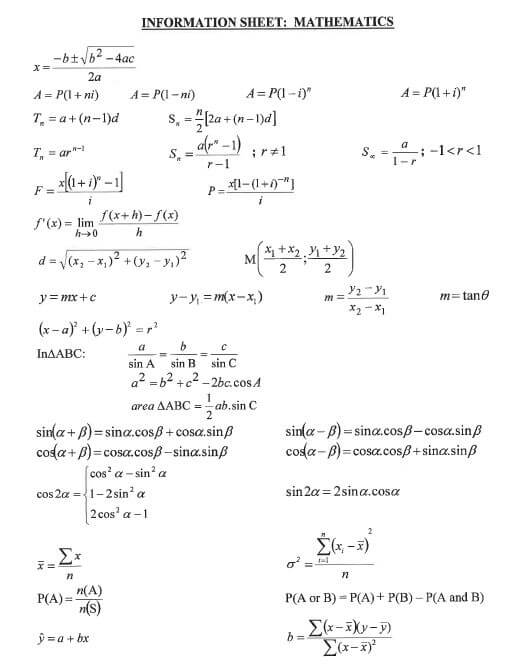MATHEMATICS PAPER 2 GRADE 12 QUESTIONS - AMENDED SENIOR CERTIFICATE EXAMS PAST PAPERS AND MEMOS MAY/JUNE 2018
Share via Whatsapp Join our WhatsApp Group Join our Telegram GroupMATHEMATICS
PAPER 2
GRADE 12
AMENDED SENIOR CERTIFICATE EXAMS
PAST PAPERS AND MEMOS
MAY/JUNE 2018
INSTRUCTIONS AND INFORMATION
Read the following instructions carefully before answering the questions.
- This question paper consists of 10 questions.
- Answer ALL the questions in the SPECIAL ANSWER BOOK provided.
- Clearly show ALL calculations, diagrams, graphs, etc. that you have used in determining your answers.
- Answers only will NOT necessarily be awarded full marks.
- You may use an approved scientific calculator (non-programmable and non-graphical), unless stated otherwise.
- Unless stated otherwise, round off answers to TWO decimal places.
- Diagrams are NOT necessarily drawn to scale.
- An information sheet with formulae is included at the end of the question paper.
- Write neatly and legibly.
QUESTIONS
QUESTION 1
The monthly profit (in thousands of rands) made by a company in a year is given in the table below.
| 110 | 112 | 156 | 164 | 167 | 169 |
| 171 | 176 | 192 | 228 | 278 | 360 |
1.1 Calculate the:
1.1.1 Mean profit for the year (3)
1.1.2 Median profit for the year (1)
1.2 On the number line provided in the ANSWER BOOK, draw a box and whisker diagram to represent the data. (2)
1.3 Hence, determine the interquartile range of the data. (1)
1.4 Comment on the skewness in the distribution of the data. (1)
1.5 For the given data:
1.5.1 Calculate the standard deviation (1)
1.5.2 Determine the number of months in which the profit was less than one standard deviation below the mean (2) [11]
QUESTION 2
It is said that the number of times that a cricket chirps in a minute gives a very good indication of the air temperature (in °C). The table below shows the information recorded during an observation study.
| CHIRPS PER MINUTE | AIR TEMPERATURE IN ºC |
| 32 | 8 |
| 40 | 10 |
| 52 | 12 |
| 76 | 15 |
| 92 | 17 |
| 112 | 20 |
| 128 | 25 |
| 180 | 28 |
| 184 | 30 |
| 200 | 35 |
2.1 Represent the data above on the grid provided in the ANSWER BOOK. (3)
2.2 Explain why the claim, 'gives a very good indication', is TRUE. (1)
2.3 Determine the equation of the least squares regression line of the data. (3)
2.4 Predict the air temperature (in °C) if a cricket chirps 80 times a minute. (2) [9]
QUESTION 3
In the diagram, ABCD is a quadrilateral having vertices A(7 ; 1), B(- 2 ; 9), C(-3 ; - 4) and D(8 ; -11). M is the midpoint of BD.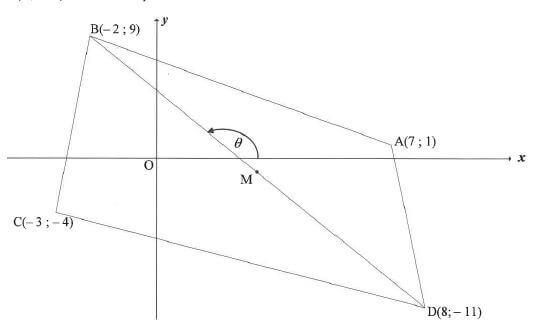
3.1 Calculate the gradient of AC. (2)
3.2 Determine:
3.2.1 The equation of AC in the form y = mx + c (2)
3.2.2 Whether M lies on AC (4)
3.3 Prove that BD ⊥ AC. (3)
3.4 Calculate:
3.4.1 θ, the inclination of BD (2)
3.4.2 The size of CBD (3)
3.4.3 The length of AC (2)
3.4.4 The area of ABCD (5) [23]
QUESTION 4
In the diagram, a circle having centre at the origin passes through P(4 ; -6). PO is the diameter of a smaller circle having centre at M. The diameter RS of the larger circle is a tangent to the smaller circle at 0.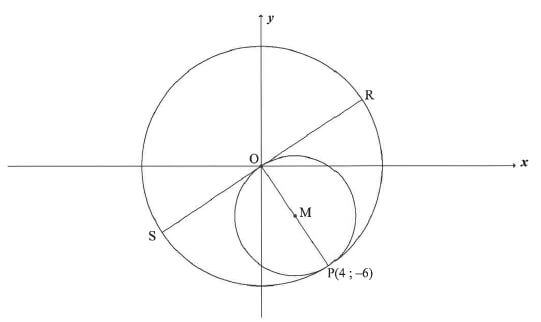
4.1 Calculate the coordinates of M. (2)
4.2 Determine the equation of:
4.2.1 The large circle (2)
4.2.2 The small circle in the form x2 + y2 + Cx + Dy + E = 0 (3)
4.2.3 The equation of RS in the form y = MX + c (3)
4.3 Determine the length of chord NR, where N is the reflection of R in the y-axis. (4)
4.4 The circle with centre at M is reflected about the x-axis to form another circle centred at K. Calculate the length of the common chord of these two circles. (3) [17]
QUESTION 5
5.1 In ΔMNP, N = 90° and sin M =15.
17
Determine, without using a calculator:
5.1.1 tan M (3)
5.1.2 The length of NP if MP = 51 (2)
5.2 Simplify to a single term: cos(x - 360º).sin(90º + x) + cos2(-x) -1 (4)
5.3 Consider: sin(2x + 40º)cos (x + 30º) - cos(2x + 40º) sin(x + 30º)
5.3.1 Write as a single trigonometric term in its simplest form. (2)
5.3.2 Determine the general solution of the following equation: sin(2x + 40º) cos(x + 30º) - cos(2x + 40º) sin(x + 30°) = cos(2x - 20º) (7) [18]
QUESTION 6
In the diagram, the graphs of f (x) = -3 sin x/2 and g(x) = 2 cos(x - 60°) are drawn in the interval x∈[-180°;180°] . T(p ; q) is a turning point of g with p < 0.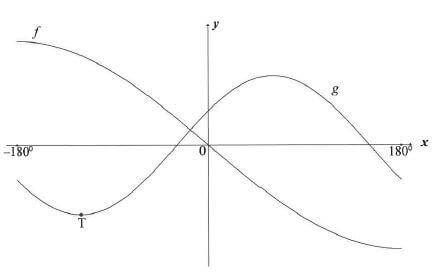
6.1 Write down the period of f (1)
6.2 Write down the range of g. (2)
6.3 Calculate f(p) - g(p). (3)
6.4 Use the graphs to determine the value(s) of x in the interval x∈[-180° ;180] for which:
6.4.1 g(x) > 0 (3)
6.4.2 g (x). gl (x) > 0 (4) [13]
QUESTION 7
The captain of a boat at sea, at point Q, notices a lighthouse PM directly north of his position. He determines that the angle of elevation of P, the top of the lighthouse, from Q is 8 and the height of the lighthouse is x metres. From point Q the captain sails 12x metres in a direction /3 degrees east of north to point R. From point R, he notices that the angle of
elevation of P is also O. Q, M and R lie in the same horizontal plane.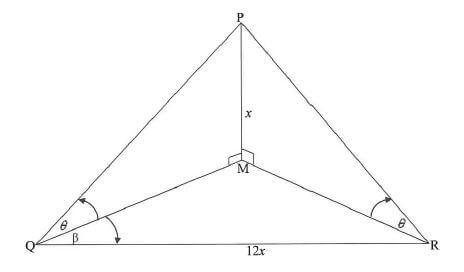
7.1 Write QM in terms of x and 0. (2)
7.2 Prove that tan θ = cos ß (4)
6
7.3 If = 40° and QM = 60 metres, calculate the height of the lighthouse to the nearest metre. (3) [9]
QUESTION 8
8.1 In the diagram, 0 is the centre of the circle. Radii OH and OJ are drawn. A tangent is drawn from K to touch the circle at H. ΔHGJ is drawn such that GJ II KH. OI = 2x .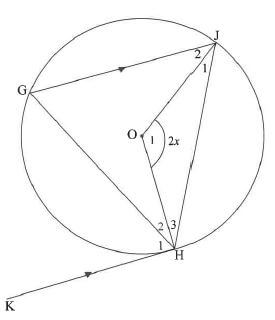
8.1.1 Name, giving reasons, THREE angles, each equal to x. (5)
8.1.2 Prove that fI2 =143. (3)
8.2 In the diagram, KLMN is a cyclic quadrilateral with KLM = 87°. Diagonals LN and MK are drawn. P is a point on the circle and MP is produced to T, a point outside the circle.
Chord LP is drawn. LMK = y and N1 = 2y 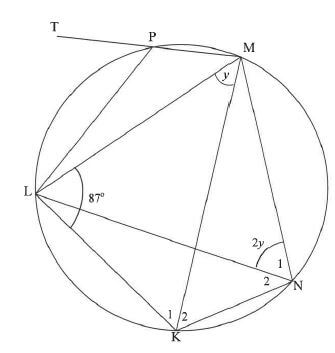
8.2.1 Name, giving a reason, another angle equal to y. (2)
8.2.2 Calculate, giving reasons, the size of:
- y (3)
- TPL (2) [15]
QUESTION 9
9.1 Use the diagram to prove the theorem which states that a line drawn parallel to one side of a triangle divides the other two sides proportionally, that is prove that
XK = XL
KY LZ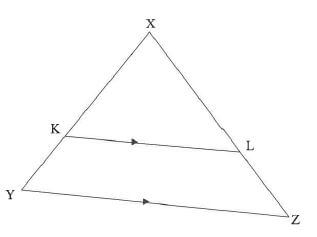 (5)
(5)
9.2 In ΔRST, F is a point on RS and H is a point on RT such that FH ΙΙ ST. RF = 2x - 10, FS = 9, RH = 4 and HT = x - 2.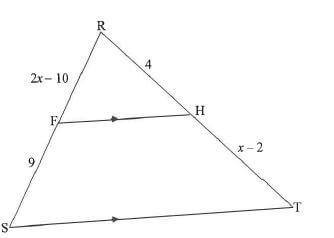
9.2.1 Determine, giving a reason, the value of x. (5)
9.2.2 Determine the ratio: area ΔRFH (4) [14]
area ΔRST
QUESTION 10
In the diagram, FBOE is a diameter of a circle with centre 0. Chord EC produced meets line BA at A, outside the circle. D is the midpoint of CE. OD and FC are drawn. AFBC is a cyclic quadrilateral.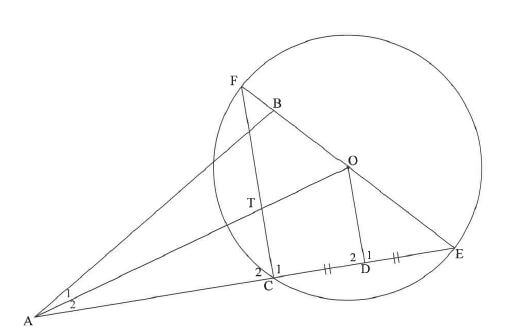
10.1 Prove, giving reasons, that:
10.1.1 FC II OD (5)
10.1.2 DOE = BAE (4)
10.1.3 AB x OF = AE x OD (7)
10.2 If it is further given that AT = 3T0, prove that 5CE2 = 2BE.FE (5) [21]
TOTAL: 150
